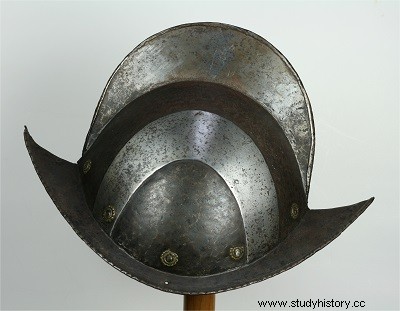
The morion is a European helmet in use in the 16th and 17th centuries, open, from the iron chapel and close to the cabasset1. It is characterized by its high crest.
History, uses and evolution
The morion would have appeared in Spain at the beginning of the 16th century and the French word is also directly borrowed from the Spanish morrión. The name could come from the Moors, although its most likely etymology brings it back to the Spanish word morro, "snout, mouth" also used to designate rounded objects resembling the head, from the lower Latin murrum "muzzle, mouth".
The morion was especially made famous by the Spaniards during the Renaissance, especially by the conquistadores. However, it was made fashionable by the Germans in the middle of the 16th century and gained great popularity with all European armies [ref. desired]. It was notably adopted in Switzerland and made its appearance in the English army under Edward VI, to cover the pikemen. Today it is still worn by the Vatican Swiss Guards.
The morion first equipped the pikemen4 and then the city guards, the personal guards and certain European royal guards. Then, for a century, he served with the light cavalry, the arquebusiers and the infantry. It was often worn with half armour.
Shapes and characteristics
The morion is formed of a hemispherical cap surmounted by a large ridge and wide boat-shaped edges, very raised at the front and at the rear, where they end in a point. Larger morions are sometimes equipped with cheek guards. The sturdiest morions are forged from a single piece of metal.
Certainly because of its use by personal guards, artistic research can sometimes be very advanced, especially with a very elaborate form. It is also often richly decorated with engraved or embossed motifs, embellished with rivets or brass rosettes. At the back, a tube can be attached to allow the carrying of a feather plume.
